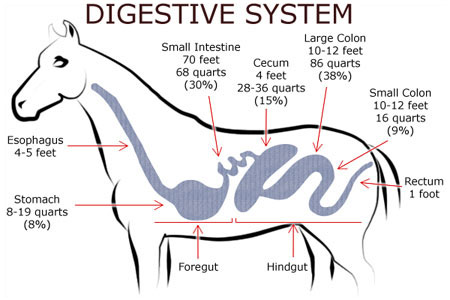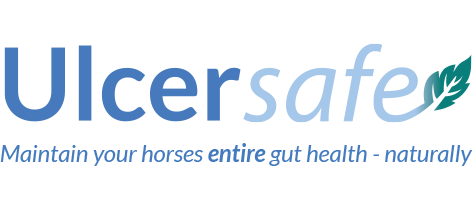About Ulcers
EGUS as a disease complex associated with ulceration of the oesophageal, gastric, or duodenal mucosa and can (and most probably will!) affect a horse no matter what age, breed or sex
Why do horses get ulcers?
Through the unnatural regime and diet we give them and through stress. We have changed their natural regime and diet; we confine them; we feed infrequently (thereby the gastric acid that is being delivered to the stomach constantly has nothing to break down - except the gut lining) and exercise. Stress increases the production of Hydrochloric Acid which burns into and through the lying of the stomach and gut. Travelling, separation, competition, noise etc all contribute to stress levels. Long term use of certain drugs (such as ‘Bute’)
How likely is my horse to have ulcers?
Scoping and autopsies have proven that not only do most (around 60%) of stabled horses and 90% of competition horses have ulcers, even horses at rest have a 30% chance of having ulcers. Latest research has suggested that virtually all horses will have ulcers at some time.
How will I know if my horse has ulcers?
There may not be any obvious signs. He may just be feeling or performing 90% at his best. Or, he may have a dull coat, be underweight, have a poor attitude, weave, crib bite, have bouts of colic, be off his feed, be grumpy, difficult to train
An endoscopy (scoping) performed by your vet will show if your horse has ulcers in the foregut A camera on a 10’ flexible instrument (endoscope) is passed through your horse’s nostril and is the only accurate diagnostic tool we have. However, your horse must be starved for 12 hours; it’s an intrusive process and the endoscope can only reach the stomach and NOT your horse’s hind gut.
Once present, ulcers cause pain and therefore reduce your horse’s appetite - which leads to more unused acid eating away at the gut lining and therefore greater ulceration and more damage, so the faster you respond the greater your chance of reducing the pain and damage.

The stomach of the horse is relatively small - less than 10% of the capacity of the small intestine, which is why horses cannot handle large amounts of feed and instead should be fed frequent small portions, otherwise if fed too much a portion of the feed may pass undigested into the hindgut and cause ulcers there.
The horse is by nature a trickle feeder and so its gut produces a litre and a half of gastric acid every hour, 24 hours a day. When food reaches the stomach it causes the release of enzymes and acids, including hydrochloric acid that help break food down. But it is actually secreted continuously, even in the absence of food. Therefore a prolonged amount of time between meals, as is common for domesticated horses, contributes to ulcer formation and exacerbation.
The acid produced is normally maintained in the bottom portion (glandular mucosa) of the horse’s stomach, which contains the acid-producing glands. Ulcers are less prevalent here due to it having more protective factors, but excess acid produced by stress, infrequent feeds, exercise and undigested grain cause the acid level to literally rise into the unprotected top portion of the stomach (squamous mucosa), which has a thinner lining, enabling the acid to eat through causing ulceration and acid burn craters. Acid splashing around in the upper portion of the stomach causes your horse discomfort and affects his performance - which is why exercise makes the situation worse.
However, recently researchers split the condition into two categories, ESGD and EGGD, because of each one’s distinct pathology, risk factors, diagnostics, and treatment approaches. Equine Squamous Gastric Disease (ESGD) affects the upper squamous region of the horse’s stomach, which is unprotected from gastric acid. Equine Glandular Gastric Disease (EGGD) involves the lower region and is actually the more problematic of the two diseases because it is harder to treat than and far less responsive to treatment with omeprazole. In one study 86% of Grade 1 or 2 ESGD horses healed after a 28-day omeprazole regimen, while only 14% of Grade 1 or 2 EGGD horses healed.
Hindgut ulcers - 2 out of 3 performance horse have them!
We’ve only recently found out more about hindgut ulcers, because they can’t be detected by scoping, as scoping only reaches the foregut. However, thanks to studies of the hindgut from 565 autopsies we are beginning to realise that the hindgut has its own major ulcer problems - over 65% of performance horses in the study had hindgut ulcers.
Again, these are caused by excess acid in the gut, not only from stress but also by undigested grain, which in itself creates volatile fatty acids, gas and lactic acid adding to the acidic ph. Veterinary prescribed Omeprazole is a proton pump inhibitor, blocking up to 90% of acid production in the horse’s stomach and thereby quickly improving the symptoms. However, there are concerns as to how long the horse should be deprived of 90% of its acid production as acid is needed to effectively breakdown grain in the foregut, otherwise it reaches the hindgut undigested and can cause ulcers there.
There are trillions of good bacteria in the hindgut, which an acid environment kills off, causing them to release endotoxins(poisons) in the process. These toxins can cause laminitis. The good bacteria are then replaced by bad bacteria that can thrive in this more acidic environment. The bad bacteria damage the intestinal mucosa (lining) allowing the toxins to enter the bloodstream.
The discomfort ulcers cause puts your horse off eating and makes him tetchy. It can also cause horses to start cribbing, weaving or box walking. Other signs and consequences are bouts of mild diarrohea and/or colic that can, of course, progress to more dire consequences.
Acid burn craters anywhere in the gut can end up deep enough to cause bleeding or can penetrate the gut and even results in death.When acid burn craters heal they can create scar tissue and strictures, especially in the small intestine.
Scoping (endoscopy)
Endoscopic diagnosis is limited to only the stomach and a small portion of the small intestine (so mainly the foregut) If endoscopy is not practical, or in the case of the hind gut, not possible, then a presumptive diagnosis may be made based on clinical signs and history.
Ulcers can occur in as little as 5 days.
Stress ulcers: 20 horses were scoped free of ulcers. 10 were taken to a show and 10 stabled at home. After 5 days, 7 of the 10 that had been to the show had ulcers - and so did 2 of the 10 left at home!
How common are they? 93% of racehorses have them
80% + competition horses have them
51% of foals have them after weaning
Many performance horses are being condemned as having a bad temperament, being unco-operative and aggressive - all because of our ignorance of ulcers.
Claims of benefits from natural herbal remedies are not permitted. Under current legislation we are not permitted to make claims in support of specific health benefits derived from natural herbal formulations.This means we cannot make specific statements as to how herbal supplements and formulations may help your horse.
Giving your horse our herbal supplements and formulations should be a decision based on your personal research and understanding of the role of how food-derived constituents play a role in the maintenance of health and well-being.The information provided within this site is for information or educational purposes only and is not intended as a substitute for advice from your veterinary health advisor.Do not discontinue any other medical treatments without first consulting your vet.
 UK visitors please click
UK visitors please click 


